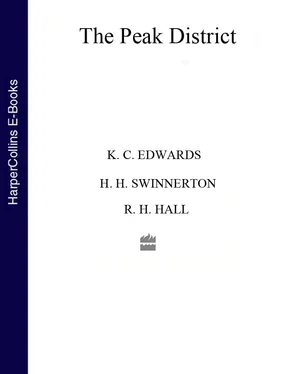The wet surfaces over which the escaping water flows become moss-grown. The moss, however, takes up the carbon dioxide from this water with the result that it can no longer hold much lime in solution. The latter is therefore deposited and, covering the moss, forms a spongy-looking rock called tufa. This is often used for rockeries and sometimes for building as in the case of Tufa Cottage in the Via Gellia. In some springs the water rises from great depth and as it does so the pressure upon it diminishes rapidly. Once more much of the lime held in solution is set free and covers any objects, such as toys and birds’ nests that are put into it, with a hard coating lime. As they have the appearance of having been changed to stone such springs are spoken of as petrifying wells.
In caves the water dropping from the roof or flowing down the sides also parts with its lime. In so doing it deposits this either as icicle-shaped pendants from the roof or as pinnacles rising from the floor. These features are known as stalactites and stalagmites respectively. Sheets of lime may also be laid over the walls or hang like curtains from ridges on the ceiling. When such a cave is judiciously illuminated it becomes a beautiful scene and a profitable centre of attraction.
WITHIN THE DALES
The rambler approaching Dovedale and the uplands along the Belper-Ashbourne road begins to catch visions of the promised land when he passes beyond Hulland. He looks across a succession of level-topped hills with an altitude of six or seven hundred feet. These level tops are relics of a mid-Pliocene peneplained platform. Away in the distance beyond them the uplands appear as a lofty rampart, bounding this platform on the north, and extending to the Weaver Hills.
In the centre of the rampart is Thorpe Cloud, rising like a bastion at the entry to Dovedale. Making that his first objective, he scrambles to the top and, looking northwards, finds himself on a level with the upper or early Pliocene platform and sees it as a gently undulating landscape having all the general characteristics of a peneplain (Plate VIIa, see here).
In striking contrast to that is the deep steep-sided dale looking like a cleft in that ancient landscape. Closer inspection of the cleft reveals a feature that is easily overlooked. The precipitous sides of the cleft do not rise to the level of the upland itself for their rims spread out like a shallow funnel about 200 feet deep. The sides of this funnel curve upwards from the lips of the gorge to the level of the upland platform. The funnel is in fact the profile or cross-section of a moderately broad valley in the floor of which the gorge has been carved. This floor extends southwards into the 600-700-foot platform already noticed between Hulland and Ashbourne. The sight of this valley takes the thoughts back to middle Pliocene times when the Dove flowed along this floor and debouched on to the plain of which this platform is a survival.
Leaving his eyrie, the rambler descends and sets out to explore the dale (Plate 2a, see here). At first his path lies alongside the stream. Presently it rises steeply and takes him up to the Lover’s Leap, the name given to a spur which projects towards the gorge. Standing upon the tip of the spur he looks down into the gorge and his eyes come to rest on the wooded slopes of the opposite side. Here and there amongst the greenery may be seen grey pinnacles of limestone known as the Twelve Apostles. How these came to be there will emerge later. For the present it must suffice to say that they are the degraded remnants of another spur that once projected from the other side, the counterpart of the Lover’s Leap.
Turning back from viewing the Twelve Apostles, it is seen that the flat surface of the Leap slopes upwards like a valley side and merges into the upper plain. Looking up the dale similar spurs may be seen farther on. Each of these shows the same traces of the old valley features, for all these spurs are also relics of the mid-Pliocene valley. The observer is standing where at that far distant date the Dove actually flowed.
Leaving the Lover’s Leap behind, the explorer descends past the successive levels through which the river excavated on its way down to its present bed. Once more the path lies alongside the stream through smooth grassy flats unimpeded by boulders. On either side are the rocky cliffs criss-crossed by vertical cracks or joints and horizontal or gently dipping bedding planes. In winter some of these become filled with water from melting snow. When this freezes it expands and the ice, acting like a quarryman’s wedge, gradually prises lumps of rock from the face of the cliff which fall and form a blocky scree at the base (Plate VIa, see here).
Here and there other narrow spurs once projected into the dale, but these have been partly or wholly destroyed. Frost working at both sides of the spur has worked its way in along major joints or fractures and cut it up into isolated columns such as that of the Ilam Rock (Plate III, see here). Rain falling upon such a column dissolves the corners and edges and eventually reduces it to the shape of a pinnacle such as those already seen from the Lover’s Leap.
Another feature of the dale that is easily overlooked is the fact that it follows a winding course. One result of this is that the vistas are usually not long but are closed in by a succession of rocky pictures often of great beauty. As each bend of the gorge is passed there come into view new cliffs, fresh and fantastic shapes or even a cave, such as Dove Hole and Reynard’s Cave. These last are a reminder that the excavating of the dale has not been entirely due to the direct deepening of the river channel. Disappearing streams like those of the Lathkill and the Manifold have played their part by dissolving underground passage-ways beneath the floor of the dale which became open to the air and the sunshine, in the way already described for Lathkill Dale, and henceforth became part of the main dale. The two caves just mentioned were formed by tributary streams which, however, were drained dry when the Dove itself deepened its channel below their level.
The winding of the dale is reminiscent of the meanders of a river flowing along an alluvial plain. When such a river is rejuvenated the knick point, followed by the deepened channel, travels upstream along the meandering course round bend after bend. Such was the history of the Dove when, with the mid-Pliocene uplift, it became rejuvenated and incised its new valley into the early Pliocene peneplain, and at a later date excavated the dale in the floor of that valley.
At last the explorer comes to the end of the dale and finds that it opens out into a normal valley. From this point up to its source on Axe Edge it does not flow over limestone but over shale with some grits. As already seen these shales yield much more readily than does limestone to the destructive influence of rain and frost. When therefore this uppermost section of the river came under the influence of the latest rejuvenation, the sides of the deepening channel were more rapidly worn back and a wide valley formed.
THE MOORLANDS
The striking change of scenery met with along the upper reaches of the Dove is a reminder that the limestone uplands form only part of the Peak District; the other part is made up of grits and shales. The change reflects the still greater contrast between the uplands and the moors. This gives to the district much of its attractiveness as is typified by the streams of visitors to the dales and the comparative trickle of energetic hikers who make the lofty, windswept moors their main objectives.
The rocks which form the moorlands completely encircle the uplands like the oval frame of a beautiful portrait. At the top of the frame, where the grits have their maximum thickness, the moulding stands out in bold relief. Along the sides this declines and at the bottom it almost disappears for the grits become much thinner as they pass southwards round the limestone. On the south such features as they produce still remain largely hidden under ancient covering of Triassic sands and marls.
Читать дальше












